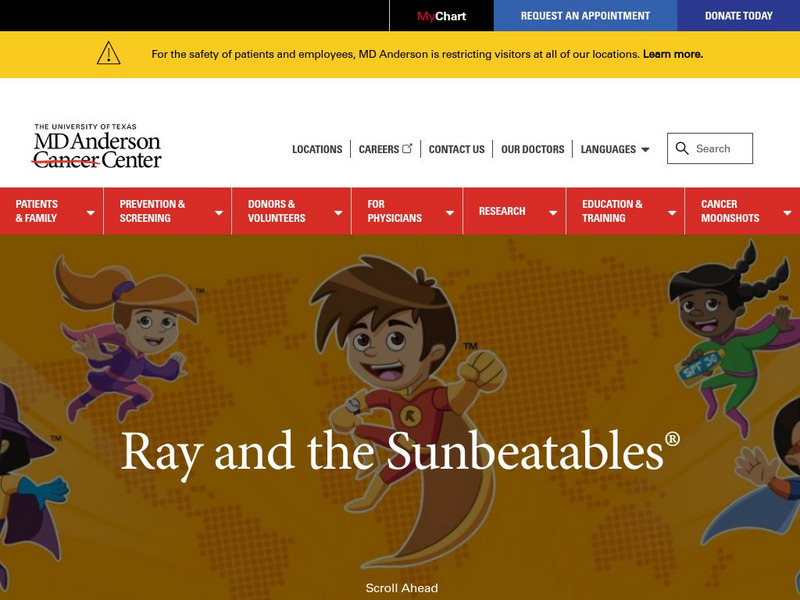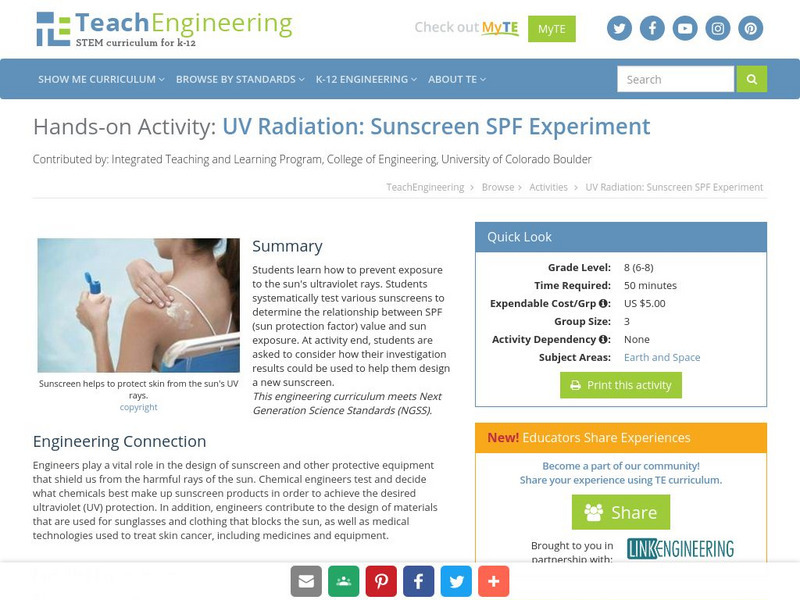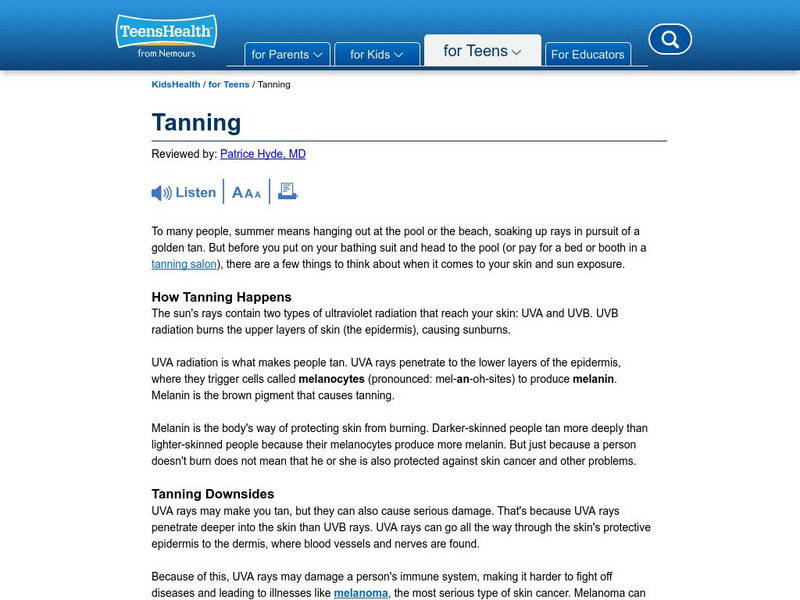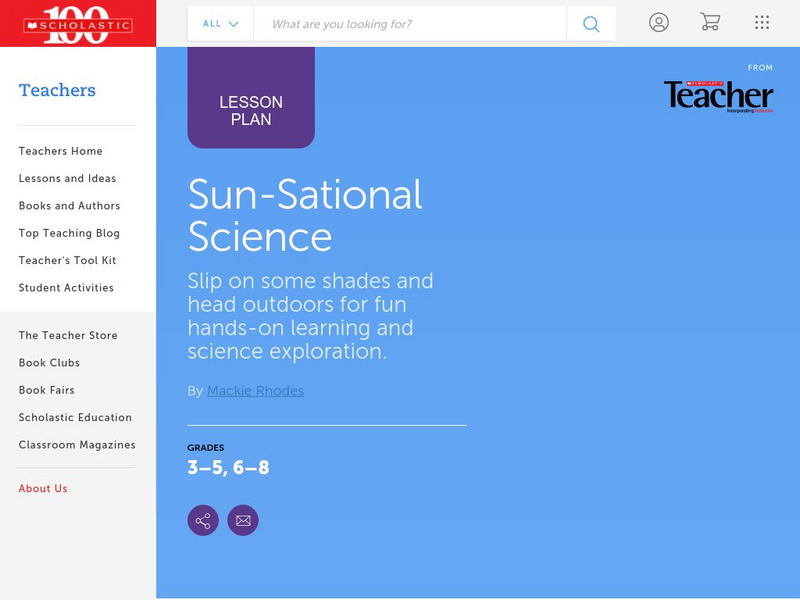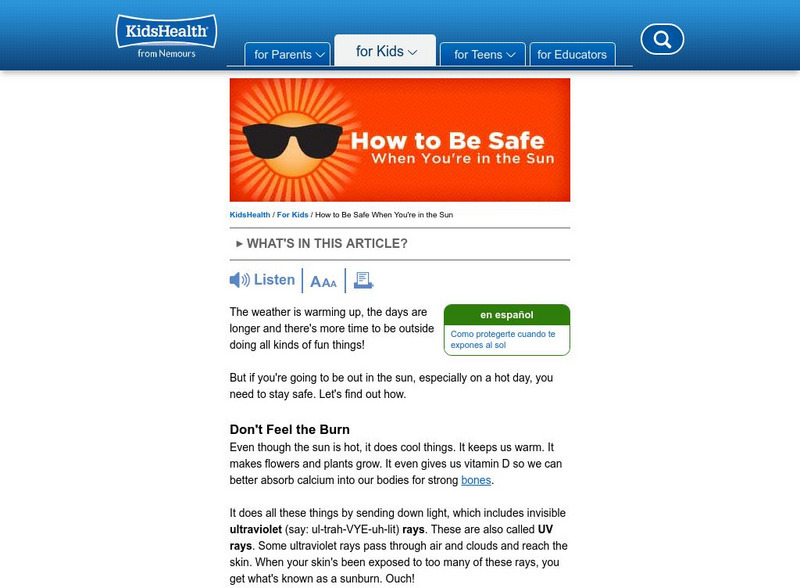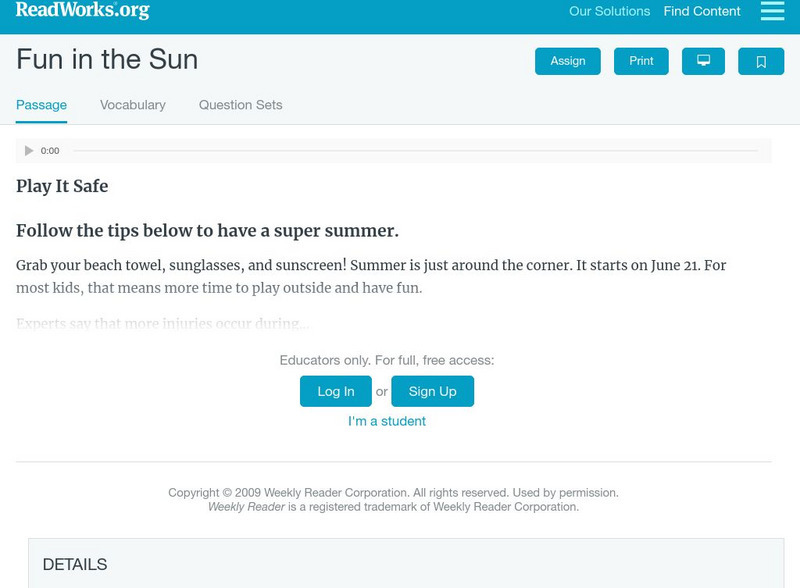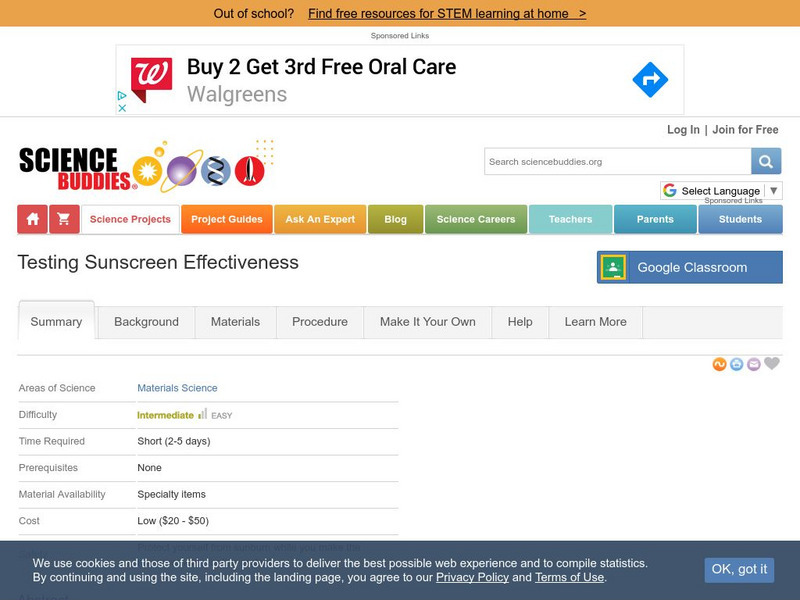Curated OER
Kids Health: Sun Safety
Learn why the Sun keeps us healthy, and also, learn how the Sun can harm our skin, eyes, and immune system. Read about the dangers associated with the Sun's ultraviolet rays, and read tips to help you stay safe when outside in the summer...
University of Texas Libraries
University of Texas: Ray and the Sunbeatables
The University of Texas MD Anderson Cancer Center created and developed Ray and the Sunbeatables: A Sun Safety Curriculum. The evidence-based curriculum educates children, parents and teachers about sun protection and promotes sun safety...
TeachEngineering
Teach Engineering: It Burns!
In this activity, students learn how to prevent exposure to the Sun's harmful ultraviolet rays. Students will systematically test various sunscreens to determine the relationship between spf (sun protection factor) value and sun...
Curated OER
Kids Health: Tanning
Most people, especially young adults, think they look better with a tan. But excessive sun exposure can cause serious damage to your skin and can lead to skin cancer. Find out how to be smart in the sun.
Curated OER
Kids Health: Sun Smarts
Sunburn isn't just painful, it's dangerous. Learn about the connection between sun exposure and skin cancer, and learn how treat sunburn. Also, learn how to prevent getting sunburn with three simple tips. Use the links on this page to...
Centers for Disease Control and Prevention
Centers for Disease Control: Bam! Your Safety: Sun Proof
Tips for protecting yourself from the sun.
Crayola
Crayola: Fun in the Sun Visors
This activity shows children how to make sun visors using simple paper plates, markers, and a rubber band.
Scholastic
Scholastic Instructor: Sun Sational Science
Discover more about the sun when you visit this educational resource. The content of this site includes solar fun facts, experiments, and activities.
NASA
Nasa: Eye Safety During Solar Eclipses
This resource, which is provided for by NASA, gives great information on protecting your eyes during solar eclipses. Your eyes are very difficult to replace. Even when 99% of the Sun's surface is obscured during the partial phases of a...
Curated OER
Kids Health: How to Be Safe When You're in the Sun
Learn about the sun's harmful effects on human skin and find simple tips that help prevent getting sunburn, which can lead to skin cancer.
Read Works
Read Works: Fun in the Sun
[Free Registration/Login Required] An informational text explaining ways to stay safe while enjoying the summer. A question sheet is available to help students build skills in reading comprehension.
Environmental Education for Kids
Eek!: Outdoor Safety: Jeepers, Creepers, How Do You Protect Your Peepers?
Learn how to protect your eyes from harmful sun rays.
National Geographic
National Geographic: Build a Solar Eclipse Viewer
This lesson focuses on How can you safely view a solar eclipse and solar activity? It provides step-by-step instructions for building the viewer and how to use it properly. It also provides a video and informational slides.
TED Talks
Ted: Ted Ed: Why Do We Have to Wear Sunscreen?
You already know that a trip to the beach can give you a nasty sunburn, but the nitty gritty of sun safety is actually much more complex. Wrinkle-causing UVA rays and burn-inducing UVB's can pose a serious risk to your health (and good...
TED Talks
Ted: Ted Ed: Which Sunscreen Should You Choose?
Mary Poffenroth explains how sunscreens work and compares different application methods, SPFs, and active ingredients to help you make the best choice. [4:39]
Utah Education Network
Uen: Trb 3:5 Investigation 3 It's Hot
Activity helps to understand the effect of sunlight on the earth.
Environmental Education for Kids
Eek!: Outdoor Safety: Warning! The Rays of the Sun Can Be Harmful!
Learn about the harmful effects on humans of ultraviolet radiation caused by the depletion of the ozone layer.
Alabama Learning Exchange
Alex: Ultraviolet Radiation
An interactive PowerPoint will be used to introduce the electromagnetic spectrum. Students use UV beads to observe changes caused by the sun's rays and evaluate sunscreen effectiveness. Harmful effects of UV exposure will be described...
Curated OER
Kids Health: Heat Illness
Being out in the sun and heat, especially while exercising or participating in any physical activity, can lead to heat exaustion and heatstroke. Learn how to prevent getting sick while in the sun, and learn how to cool down if you feel ill.
PBS
Pbs Kids: Science Rocks: Build a Tent
This site provides instructions on how to build a tent including materials needed. It focuses primarily on a model tent but gives hints to adapt it to an outdoor tent that could provide shelter from the weather.
Science Buddies
Science Buddies: Testing Sunscreen Effectiveness
The goal of this project is to measure the effectiveness of different sunscreen products for blocking ultraviolet-A (UVB) and ultraviolet-B (UVB) rays from sunlight. This project shows you how to use a UV detector to measure rays of light.
National Institutes of Health
Niehs: Kids' Pages: You and Your Genes
Online children's story that teaches about genes and how they direct how you react to things in your environment. Click on "next" at the bottom of the story to see how different people respond differently to harmful substances.
Texas Instruments
Texas Instruments: Comparing Sunscreens
In this activity, students use the UVB Sensor to measure the amount of UVB light that passes through a thin film of sunscreen. They analyze the relationship between the SPF values and the intensity of UVB light transmitted by the sunscreen.
Other popular searches
- Sun Safety Activities
- Summer Sun Safety
- Health & Sun Safety
- Hats Sun Safety
- Media Influence Sun Safety
- Health: Sun Safety
- Ozone and Sun Protection
- Sun Safety Lesson Plans
- Social Influence Sun Safety
- Pool & Sun Safety
- Sun Protection Activities
- Sun Protection Body Care

